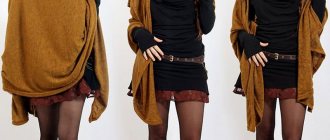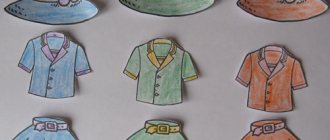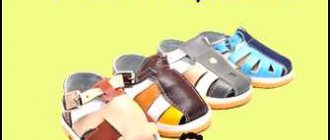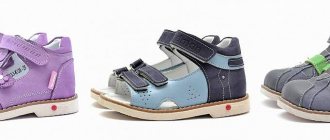Conducting a creative lesson “Clothes and shoes” in the middle group
Drawing classes in the middle group are often playful in nature. The kids will not be interested in the task “We need to draw boots,” but communicating with the toy character and making boots for him will definitely be to their liking. Thus, the introductory part of classes on drawing clothes is aimed at repeating the features of objects on the topic and at the same time motivating children for practical work.
Table: motivating start of the lesson
| Lesson topic | Variant of the introductory part |
| "Scarf for matryoshka" | Solving a problem situation. Dolls (toys or pictures with plain scarves) come to the group and tell the children that an exhibition will soon be held at the local history museum, but the masters do not have time to paint them. Children offer help. |
| "Sweater Decoration" | Surprise moment. A package for children and dolls arrives in the play corner. It contains sweater blanks. The dolls complain that they are all the same and ask the guys to decorate them. |
| "Dress for my beloved mother" | Studying visual material: photographs, postcards or presentations with women's dresses. Conducting a conversation:
|
Studying visual material requires mandatory discussion
Drawing lesson notes
Lesson outline for the middle group:
- Goals and objectives.
- Preliminary work.
- Didactic materials and drawing tools.
- GCD plan:
- Organizational moment - 1 minute.
- Introductory information stage - 3–4 minutes.
- Practical part - 13–14 minutes.
- Display of works, summing up - 2 minutes.
Table: drawing lesson “Decorating a Sweater” in the middle group (fragment)
| Author | Ivanova E., teacher at MBDOU D/s No. 458, Nizhny Novgorod. |
| Goals |
|
| Materials |
|
| Preliminary work |
|
| Progress of the lesson | A doll comes to visit the children. K.: Hello, guys. Children and teacher: Hello. V.: What is your name? K.: Masha. V.: We are glad to see you, Masha, as our guest. But it seems to me that you are sad. What has happened with you? K.: We went to the store and wanted to buy sweaters, but they were all white. And we wanted beautiful, colorful ones. V.: Don’t be upset, Masha. Our guys are so smart and will help you. Guys, can you decorate the sweaters? D.: Yes. V.: Well, then let’s go visit the dolls. Children with a teacher and a doll go to visit the dolls. V.: So we came to visit. What kind of store is there? What's on sale here? D.: Sweaters. Q: What color are they? D.: White. V.: Indeed, they are all white. There are so many of them! And when do you guys wear warm clothes? D: When it’s cold. V.: That's right, in the cold season. In winter and autumn. Guys, do you want to decorate them so that the dolls wear beautiful sweaters? D.: We want to. V.: Then take your seats. The children sit at the tables. The teacher asks what can be done to make the sweaters beautiful. Q: How can you decorate a sweater? D.: Dots, wavy lines, circles, dots. The teacher says that each child decorates the sweater as he or she wants, beautifully choosing the colors and arranging the pattern. The teacher helps the children choose paints when doing work. He praises the children and says that the dolls are very happy about such beautiful gifts. Physical education <…> At the end of the lesson, children examine and emphasize the beautiful combination of colors and patterns. The doll thanks the children and says goodbye to them. Children and teacher: It’s time for us to return to the group. Goodbye. The lesson is summarized. Children share their impressions. |
| Quote from: https://www.maam.ru/detskijsad/hudozhestvenoe-tvorchestvo-risovanie-ukrashaem-sviter-dlja-detei-srednei-grupy.html | |
The summary of the given lesson is a classic example of decorative drawing in the middle group. There is one significant remark - it is recommended to conduct physical education in the middle of the lesson, and not at the end (after the theoretical and practical parts). A dynamic pause is necessary for children as a change of activity and a way to relieve tension.
The dolls will be happy: the guys created unique things
Task 7. Learning to speak without mistakes - the words “put on” and “dress”. Let's play and remember!
A common speech error among children is the incorrect use of the words “dress” and “put on.” The rule here is: “DRESS” we say if we dress someone (we dress our son for a walk, we dress a doll, a bear, a baby, a sick person).
We always wear something - a coat, a raincoat. And “put on” is said when we “put on” ON ourselves - on our hands, on our feet. Therefore, it would be correct to say “put on trousers (for myself)”, but “put on a doll for a walk”. There is no need to remember this rule. You just need to play speech games with your child, and he will easily and playfully remember it and will no longer make mistakes. And of course, in everyday communication you need to monitor the correct use of these words (example for comparison: “Have you already put on a sweater? Well done!” “Have you already put on a bear? Great! Then the bear can go for a walk with us”)
Let's start playing!
Read a fragment from a poem by Elena Blaginina to your child.
Mom hummed a song, dressed her daughter. Dressed - put on a white shirt. White shirt, thin stitching...
Mom finished the song, Mom dressed the girl. Red dress with polka dots, New shoes on the feet. This is how my mother pleased me - she dressed up her daughter for May. This is the kind of mother she is - truly golden!
Who did mom dress? How did she dress her daughter?
A game with the word "dress".
Invite your child to play. It will be as if you are DRESSING a bear or a bunny for a walk (demonstrate these actions with gestures), and the baby will need to guess from your gestures what you are DRESSING the toy with. For example, show that you are wearing a sweater (there is no sweater, just showing with gestures) and ask: “What am I dressing Mishka in?” Or show that you are dressing Mishka in trousers and ask, “Now what did I dress him in?” You can show with a gesture how you put Mishka in a shirt and fasten the buttons on the sleeves. Then let the baby ask similar riddles for you. The word “dress” will always be used in this game, and the more often the better! “What did I dress the bear in?” - “Are you wearing a teddy bear in your jacket?” - “No, I didn’t put him in a jacket. I dressed him in something different, but similar to a jacket. Well, can you guess it?” - “Did you dress him in a coat?” etc. Repeated natural repetition of a word in a game will be remembered by the child, and he will not make mistakes.
This little rhyme for kids will help you remember better how to use the word “dress.”
A play on the word “put on.”
When the child in the first game always names the action correctly (“dress” a doll, a bear, a bunny - what? put on a fur coat, a coat, a dress, shorts), you can move on to the second game - with the word “put on”.
Show how you put something on yourself, and the baby guesses what action you showed - “Mom, did you put on your coat?” - “No, not a coat. And here’s what... (in a mysterious voice and repeat the gesture).” - “Are you wearing a fur coat? - “No, not a fur coat. I didn't wear a fur coat. I put on completely different clothes (we repeat the gesture again),” etc. Then we change roles - the child shows what kind of item of clothing he is wearing (tells us a riddle). And we guess.
Some children do not want to show with a gesture, but actually start putting on clothes in this game. Let them put it on! It won't hurt at all! And it will even add intrigue. Stand with your back to the child, close your eyes (you can blindfold yourself with a handkerchief) and begin to guess what your baby is putting on at this moment in time: “Are you wearing tights? No? Then are you wearing shorts? Also no. Mmmmm. Maybe you're wearing overalls? etc. The natural richness of this game with the word “put on” and the child’s interest in the game lead to the fact that this word and the situation of its correct use are remembered very simply and quickly. And in the future, the child will not have any problems with the correct use of the words “dress” and “put on”! And there will be no need for boring repetitions of these words in exercises, because in life everything is remembered naturally, easily and simply!






